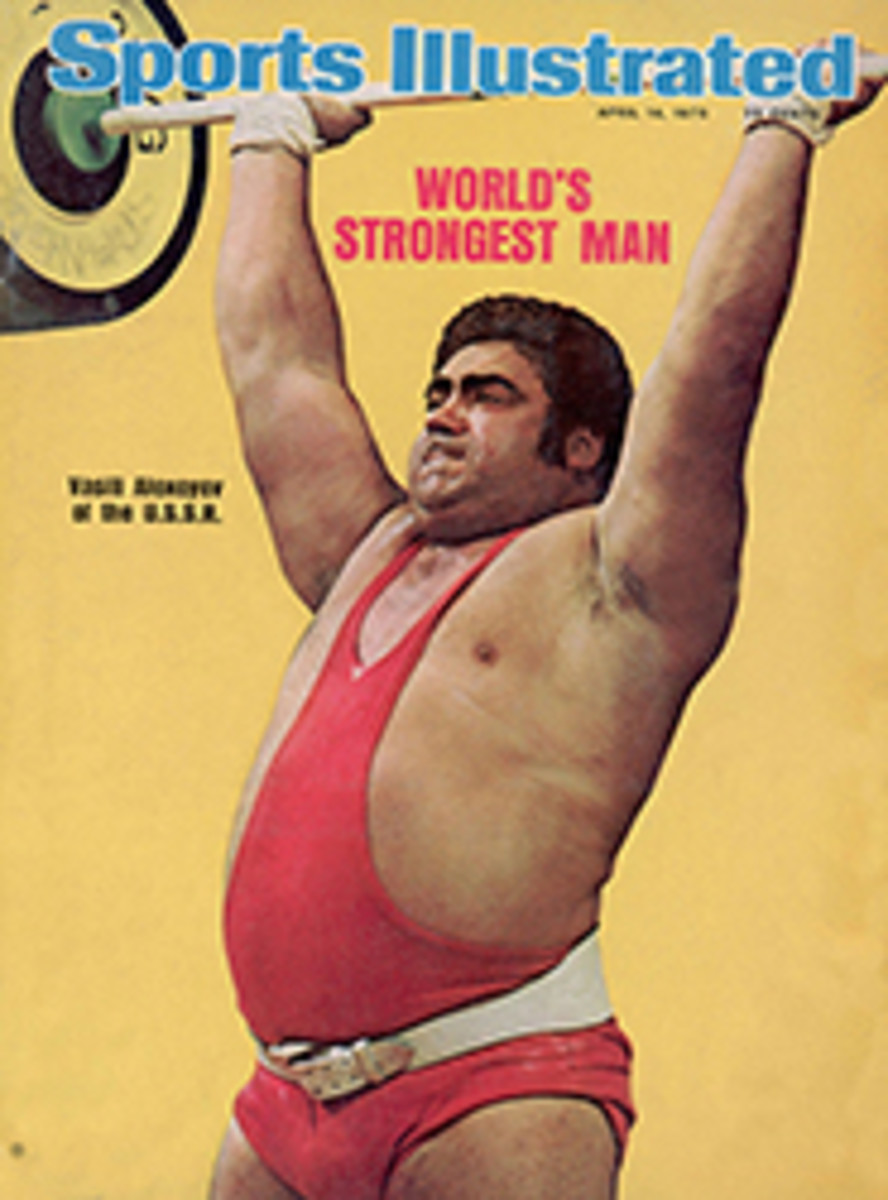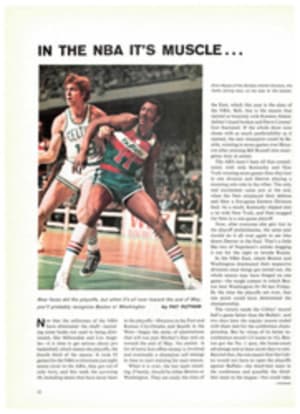
HE WHO KEEPS COOL WILL COLLECT
If the NCAA gymnastics championships staged in Terre Haute, Ind. last week served to improve U.S. standing in this highly specialized sport, a salute, indeed a formal bow, is due the Japanese. Both the team and individual all-around winners—the University of California and Wayne Young of Brigham Young—drew heavily on the techniques and philosophies of the world's premier gymnastic nation. The Japanese approach seems easy at first glance: a disciplined slow and easy does it. Over the years, however, the more impetuous U.S. gymnasts have been prone to leap in too strongly, and almost always unsuccessfully. But after last week's orgy of double backflips and flying leaps, the Japanese style seems sure to spread throughout the country like transistor radios.
The Japanese hold that success comes only with complete mastery of basic movements in the six gymnastic events: floor exercise, side horse, rings, vault, parallel bars and horizontal bar. After that, one can throw in a touch or two of Kamikaze.
When the California team arrived in what the hometown crowd calls the Queen City of the Wabash Valley—four days early to take advantage of reduced air fares—it appeared to be outclassed. Both defending champion Iowa State and LSU were unbeaten in dual meets. Moreover, Indiana State, the host school, and Nebraska had shown greater scoring potential. The Nebraskans, in fact, pulled off the surprise of the meet when they finished fifth in the opening compulsories—after spending some 32 hours snowbound at Chicago's O'Hare Airport, keeping loose by working out on the terminal floor. Among their victims in this category was Iowa State, which in recent years has been to gymnastics what UCLA is to basketball. But then California showed a few Japanese-style advantages none of the other seven teams could claim: enough depth to overcome the loss of Steve Posner, a top all-around man, balance to produce four good scores in each event and experience in the dull but vital compulsory exercises. The Bears dominated the opening compulsories and, surprisingly, did it again in the optional routines. They marched into the final round with LSU and Southern Illinois.
By Saturday it seemed clear that the Far East philosophy was paying off. Surveying the LSU lineup, Cal Assistant Coach Masayuki Watanabe, a Japanese, murmured, "They are trying more difficult routines than ours. But our execution is better. I don't think we're ready for their routines." Then he hinted that perhaps LSU was not ready for its routines, either.
When the meet was over, Southern Illinois was third and California had posted a final score of 437.3 to LSU's 433.7. "This lets everyone see for the first time what we've been working on," said Tom Weeden, Cal's finest performer. "We haven't thought in terms of competition, just progress. We knew that when everyone on the team got to a certain level we would win. Our coaches wouldn't let us rush or skip steps. It takes more time, but it works." Coach Hal Frey agreed: "I don't know if this is the beginning of a dynasty, but it could be."
Gymnastic dynasties notwithstanding, Frey minimizes the importance of collegiate titles. "The No. 1 goal of any gymnast should be to win an Olympic gold medal," he says. "I would even say that just making the Olympic team is more important than winning the NCAA title. Like the Japanese, we have to be more concerned with international success. That's why it's such a real advantage for me to have Watanabe as an assistant. I'd like to see other schools do the same."
Were it not for the fact the BYU's Young had his own Oriental masters, California might have added the individual title as well. Two years ago Young had gone to Japan for six months of training at three universities. "He was very rough when he left," says Brigham Young Coach Bruce Morganegg, "but when Wayne returned he had matured as a gymnast. He was more introspective and analytical. His workouts had become more meaningful." Young's wife Carol recalls "how confident and self-assured he was. It was hard adjusting at first because I didn't understand him. But he explained how the Japanese teach you to believe in yourself."
During his journeys Young met a Japanese instructor named Greg Sano, who has since started coaching at Brigham Young. And last week at Terre Haute, Sano was looking suitably inscrutable behind dark glasses as Young sought the all-around title.
He started firmly with 53 points on the opening compulsories. Later, in his motel room Young ate slices of an orange and carefully planned the strategy it would take to win. "You know, I will need at least a 9.1 in the pommel horse," he said. "That's my toughest event. I can't fall off the thing like I did during my compulsory routine at the conference meet."
Young was glad that the floor exercise would come first, since "It's pretty difficult to fall off the floor." And even though tendinitis in his knees has limited Young's training for this event, the routine went well, a 9.25 score. But the pommel horse, considered the most difficult event for almost every all-arounder, was next on the schedule.
Taken as an art object, the pommel horse does not look all that menacing. It is no bigger than the average pony, but with a rider aboard it can behave worse than a bucking bronco. The difficulty for gymnasts is in the constant movements that are required to move from one end of the horse to the other. There are handles, true, but they are used primarily for the difficult scissor-leg movements. Generally, the gymnast must move across the top of the horse on his palms—and in this instance the pommel-horse routine takes on overtones of a bareback ride at high speed. There are plenty of places to get off, but no safe way of doing it. When Young got off, it seemed clear he had done well, but how would the judges react? Nicely, thanks: 9.4, 9.2, 9.5, 9.3 or, after averaging the two middle scores, a fine 9.35.
"I've got it!" Young told Sano. Then he turned to see Morganegg, who had come down out of the stands to shake his hand. "Once before in a situation like that I thought about how well I was doing, and I fell off," Young said later. "This time I just concentrated on my routine."
And that did it. Obviously intent, Young finished with an outstanding 109.65 overall. "This is the best I've ever seen him," Sano said. "He now has a chance of challenging the top 10 in the Olympics."
That would indeed be high ground for the U.S., which has not produced an Olympic medal winner since 1932. The country's best hope in recent years was the diminutive Cathy Rigby, but even she finished out of the money in 1972.
Young and other top U.S. gymnasts believe there is more to their lack of success than underdeveloped skills. "I'm a novice internationally," he says. "I was in my first foreign meet only six months ago. But I've seen how difficult it is for Americans to get good scores even when we do deserve them. If I ever do reach the top 10, I'll feel as if I'm actually in the top five. That's how nationalistic the judging is."
With his touch of international experience and the NCAA title, Young may be America's leading hope in the Olympics. "I don't classify myself as the best in this country because I might lose next week," he says, "but there's nobody I can't beat. A year ago I couldn't say that."
"When I met Wayne," says Sano, "he told me he wanted to become an Olympian. So we set a schedule. Pretty soon he will be ready for more difficult routines. I don't like to hurry. It's best to build little by little."
That might also have been Watanabe talking about his California gymnasts. "You build a foundation first," he says. "You make that solid, then you add the more difficult stunts. I think other schools will start to go along with this, too."
If so, it will be the ones with a yen for success.
PHOTO
A six-month visit to Japan helped Wayne Young of BYU capture the all-around title.
PHOTO
Having a Japanese assistant coach helped the University of California win the team honors.

